2018 School Spending Survey Report
Reviews of select books by Ashley Bryan
Ashley Bryan’s Puppets:
Making Something from Everything
by Ashley Bryan; photos by Ken Hannon; photos edited by Rich Entel
Primary Atheneum 80 pp.
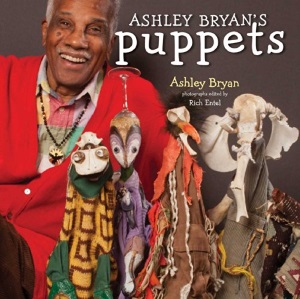 Ashley Bryan’s Puppets:
Ashley Bryan’s Puppets:Making Something from Everything
by Ashley Bryan; photos by Ken Hannon; photos edited by Rich Entel
Primary Atheneum 80 pp.
7/14 978-1-4424-8728-4 e-book ed. 978-1-4424-8729-1
It’s impossible to come away from this book without renewed respect for Ashley Bryan as a fine artist. In addition to being a storyteller and illustrator, Bryan has been making puppets from found materials for nearly sixty years. Here he presents photos and poems for a selection of those puppets, each poem told in the first person and titled with the puppet’s name (drawn from various African cultures). Made primarily from objects found on the beach in Maine — driftwood, shells, cloth, bones — these characters bear some resemblance to medieval grotesques. The poem introducing Kwesi, an elephant creature, begins, “Stew bones fashioned for a trunk, / Rib bones for a tusk; / Shoulder bones, my perfect ears, / Opal eyes a must.” A few are humorous, like Ewunike with toilet brush hair (“I’m always antiseptic”); others are “regal” (beautiful Animata, for example). One — Babatu, “Peacemaker” — bears resemblance to its creator. There’s no plot here, just puppets, and hints at individual personalities and family relationships make one wish for more. Bryan’s strong storytelling voice sometimes gives way to forced rhymes, broken rhythms, or tacked-on lessons. But the artistry shown in the puppets themselves is enough to forgive small flaws — and long for a chance to see the puppets in action. LOLLY ROBINSON
From the July/August 2014 issue of The Horn Book Magazine.
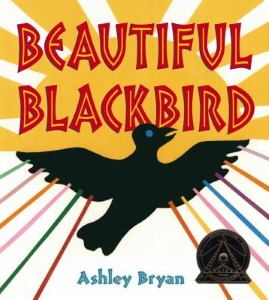
by Ashley Bryan; illus. by the author
Preschool, Primary Atheneum 40 pp.
1/03 ISBN 0-689-84731-9
Here’s a likely, life-enhancing notion — how the birds got their beautiful black markings — and a splendidly simple, scissors-and-brush way of using collage. Bryan, at the age Matisse was when he did his late, great cut-paper compositions for Jazz, has made what is more fully a picture book than anything he’s done before in a medium he’s hardly used before. Across the double-page spreads fly silhouetted birds, in luscious shades of violet, yellow, deep green, bright blue. But, assembled by Ringdove, they quickly proclaim Blackbird the most beautiful of all. “His feathers gleam all colors in the sun. / Blackbird is the most beautiful one.” The source is a folktale from Zambia, but seeing is truly believing: without markings, the birds are oddly drab, undefined. Ringdove, especially aware of his bareness, asks Blackbird to paint him a necklace of black with his blackening brew; Blackbird complies, then promises the other birds touches of black, too. In an interlace of branches that begs to be a tapestry, we see the birds in their nests — multicolor families all — dreaming of black markings on the morrow. The book concludes with the black-enhanced birds chorusing, “Our colors sport a brand-new look, / A touch of black was all it took. / Oh beautiful black, uh-huh, uh-huh / Black is beautiful, UH-HUH!” In sum, different as we may be, we can all partake of the beauty of black. Blackbird, in turn, radiates the colors of all the others. BARBARA BADER
From the March/April 2003 issue of The Horn Book Magazine.
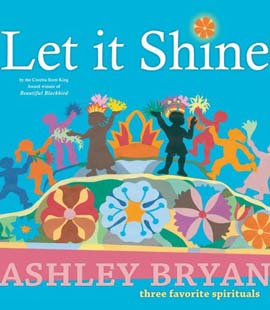
illus. by Ashley Bryan
Primary Atheneum 48 pp.
1/07 ISBN 978-0-689-84732-5
Using only cut-paper and clamorous, swirling, out-of-sight colors (lilacs and magentas, pale and deep and olive greens, tangerine and café au lait), Bryan sets three spirituals to pictures that might be projected across the back of a performance stage, they are that dynamic, that monumental and stirring. The selections are universal favorites, something Bryan emphasizes by making his figures — children and adults of all shapes and sizes — a mix of vibrant hues. In “This Little Light of Mine” the children of the world circle ’round with candles, flashlights, strings of lights. “Oh, When the Saints Go Marching In” presents a darkened Klee-esque city (“when the sun refuse to shine”) where two lone figures turn on a single light; opposite, the absent sun is represented, eerily, by three thin concentric circles. Throughout, the imagery is brilliant. Bryan has long been known for his exuberant decorative motifs — which explode here when “they crown Him Lord of Lords.” But in this instance, with three sets of lyrics that themselves are all imagery, all metaphor, his scope widens. In the climactic “He’s Got the Whole World in His Hands,” familiar, well-loved images emerge and spiral and surge across the pages, in a fusion of color and form, until the quiet, intimate touch at the close: the “little bitty baby” perched on a little finger. With words and music appended: exciting, absorbing, immensely moving. BARBARA BADER
From the January/February 2007 issue of The Horn Book Magazine.
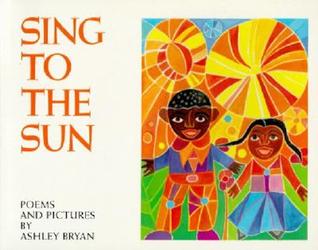 Sing to the Sun
Sing to the Sunby Ashley Bryan; illus. by the author
Primary HarperCollins 32 pp. (g)
9/92 ISBN 0-06-020829-5 PE ISBN 0-06-020833-3
In his first book of original poetry, Ashley Bryan captures with lilting rhythm the vitality of African-American and Caribbean island life. Paired with lush, vibrant paintings, the twenty-three poems in the collection cheerfully reflect nature, people, and heritage. The language is simple, compelling, and playful. The title poem, “Song,” expresses the general joyfulness of the poetry: “Sing to the sun / It will listen / And warm your words / Your joy will rise / Like the sun / And glow / Within you.” Fascinating pictures combine realistic faces with geometric shapes and dual images, conveying a primitive quality. The originality and uniqueness of all of Ashley Bryan’s work is indelibly stamped on each one. LOIS F. ANDERSON
From the March/April 1993 issue of The Horn Book Magazine.
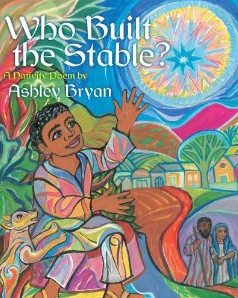 Who Built the Stable? A Nativity Poem
Who Built the Stable? A Nativity Poemby Ashley Bryan; illus. by the author
Preschool, Primary Atheneum 40 pp.
10/12 978-1-4424-0934-7
“Who built the stable / Where the Baby Jesus lay? / Was it built of bricks, / Was it built of clay?” Bryan’s child-centered verse involves readers from the very start as it tells the Nativity story from the point of view of the young shepherd/ carpenter’s apprentice who built that iconic stable. Lush illustrations offer a controlled tumult of verdant flora and fauna (on one spread multicolored elephants, lions, monkeys, and giraffes coexist with the more typical lambs and oxen). The book ends with the boy welcoming Mary and Joseph to his stable and then communing with Baby Jesus: “The boy looked in / The infant’s eyes and in his heart he knew: / The babe would be a carpenter. / He’d be a shepherd too.” MARTHA V. PARRAVANO
From the November/December 2012 issue of The Horn Book Magazine.
RELATED
RECOMMENDED
ALREADY A SUBSCRIBER? LOG IN
We are currently offering this content for free. Sign up now to activate your personal profile, where you can save articles for future viewing.







Add Comment :-
Be the first reader to comment.
Comment Policy:
Comment should not be empty !!!